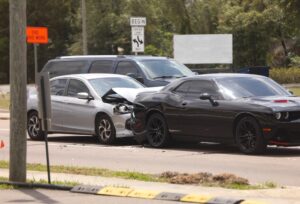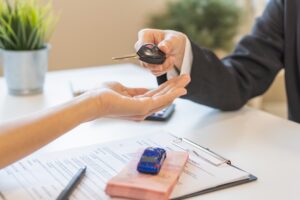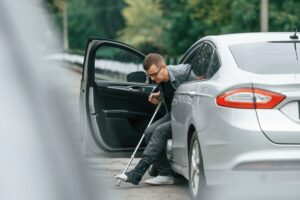If you get into a car accident while driving a friend’s car, figuring out who is liable – the car owner or the driver – is likely at the top of your mind. The often difficult and confusing claims process might involve multiple insurance policies covering multiple liable parties.
This is where a car accident lawyer can make all the difference. A Hammond car accident lawyer can examine the accident, interpret the applicable insurance policies, and guide you through the claims process toward a favorable outcome.
What Is Permissive Use in Car Accident Liability?

You’ll want to understand this concept thoroughly if you get in a wreck while you’re borrowing a friend’s car or someone else gets in a wreck while borrowing yours.
Here’s how it works: If you have a friend’s permission to use their car and get into an accident while driving it, your friend’s relevant insurance will likely cover the damage. However, if the costs exceed your friend’s insurance limits, you might need to rely on your insurance to cover the rest.
But remember, the protections of permissive use have limits. If you use the car in a way that the owner didn’t agree to, like driving recklessly or without a valid license, their insurance might not cover the accident.
Also, if you live with the car owner and regularly use their car, they might need to list you as another driver on their policy for the coverage to apply.
How Does Liability Change if the Driver of the Borrowed Car Is Underage?
The liability situation can become complex when an underage driver gets in an accident in a borrowed car. If the car’s owner gives permission to an underage driver to use their vehicle, the owner’s car insurance is usually the first to cover the damage. However, the rules can vary based on the insurance policy and state laws.
If the underage driver causes the accident, the car owner’s insurance rates will likely increase, as insurance companies see lending a car to an underage driver as a risky decision.
In cases where the expenses are more than the car owner’s insurance covers, the underage driver or their parents might be responsible for covering the rest. And if the car owner knowingly lent the car to an underaged or unlicensed driver, they might also face legal issues for doing so.
Alternatively, if the underage driver didn’t have the car owner’s permission to use the car, the car owner’s insurance might not cover the accident at all. In such a case, the underage driver or their parents might have to pay for all the damage.
Are There Circumstances Where Both the Car Owner and Driver Are Liable?
Yes, there are situations where both the car owner and the driver are liable in a car accident. This usually happens when both parties are responsible for different aspects of the accident.
Let’s look at some examples. If someone borrows a car and causes an accident, they are liable for their actions behind the wheel. However, if the car had a known mechanical issue that contributed to the accident, like faulty brakes, the car owner could also be liable for neglecting to fix it. This is because car owners are responsible for maintaining their vehicles in a safe condition.
In cases where someone borrows a car without the owner’s permission and causes an accident, the liability falls primarily on the driver. However, if the car owner negligently left the car accessible, for example, by leaving the keys in plain view, they might share some responsibility.
What Happens if the Driver Doesn’t Have Insurance? What About the Owner?
Determining liability and insurance coverage is tricky if a driver without insurance gets into an accident in a borrowed car. If the driver had permission, the car owner’s insurance policy should pay for the accident regardless of the driver’s insurance coverage.
However, the car owner’s insurance will only cover up to its policy limits. If the accident costs exceed these limits, the driver could be personally responsible for the remaining amount. This could be a serious financial burden. An uninsured driver might be unable to pay what they owe even if you took them to court and won.
If neither the driver who causes an accident nor the car’s owner has insurance, they both could face significant legal and financial responsibility. The driver might have to pay out of pocket for all the crash-related expenses, which could include vehicle repair costs, medical bills for injuries, and legal penalties for driving without insurance.
The car owner isn’t off the hook either. Most states require that car owners insure any vehicles operated on public roads. The owner might face fines and other legal actions, especially if their uninsured car was in an accident.
How Does Liability Differ in Accidents Involving Rental Cars vs. Friend’s Cars?
If you crash a rental car, the rental company’s insurance and the agreements you sign when renting the car play a big role in determining who covers the cost.
First, you may have purchased additional insurance from the rental company at the time you rented their vehicle.
Second, depending on the terms of your own auto policy, your provider might cover this liability on your behalf.
Additionally, many credit cards offer rental car insurance as a benefit. If you used such a card to pay for the rental, this benefit might provide additional coverage.
You might be personally responsible for the extra amount if the accident-related costs exceed these limits. Additionally, you could face significant financial liability if you declined the rental company’s insurance and don’t have a personal policy covering rental cars.
On the other hand, if you have an accident in a friend’s car, the liability often falls on your friend’s car insurance under permissive use. If you’re at fault in the accident, your friend’s insurance typically covers the expenses up to its policy limits. If the costs go beyond these limits, then you or your personal insurance might need to cover the rest.
How Do No-Fault Insurance Laws Affect Liability in These Scenarios?

Let’s say you get into an accident while driving a friend’s car in a no-fault state. In this case, you would file a claim with their insurance provider to cover your medical bills and a portion of your lost earnings if you cannot work, regardless of who caused the accident.
If the other driver was to blame, their liability insurance should pay for the damage to your friend’s car. If you were to blame and your friend does not have optional collision insurance, then you might have to cover the cost yourself.
If, for whatever reason, your friend does not have PIP insurance of their own, your own policy might apply. An experienced attorney can review your policy to determine the extent of its coverage.
It’s worth noting that no-fault systems still allocate fault; they just handle insurance claims differently.
If the accident results in significant damage and injuries, you can hold the at-fault driver (or the owner of the vehicle they were driving at the time) legally responsible for costs beyond what their no-fault insurance covers. Depending on the state, this could include responsibility for serious injuries or damage to other people’s property.
What Should You Do After an Accident in a Friend’s Car?
Getting into a car accident is often overwhelming, especially when it happens in a car that isn’t yours.
To protect your rights and lay a strong foundation for a car accident claim:
- Contact your friend to inform them about the accident.
- Take photos or videos from the accident scene, if possible.
- Get contact information from any witnesses who saw what happened.
- Write down your account of the accident while it’s fresh in your mind.
- Keep a record of any medical treatments and costs that relate to the crash.
- Follow your doctor’s orders and attend follow-up appointments as necessary.
- Contact a knowledgeable accident lawyer for advice as soon as possible.
- Avoid discussing liability or crash details with anyone but your lawyer.
- Document any pain or difficulties you experienced after the accident.
- Avoid posting about the accident on social media.
The most critical step on this list is to contact a car accident lawyer immediately. Any car accident claim can be a complex process, but this is especially true when matters of ownership and liability complicate matters.
Rather than untangling this yourself, turn to a professional for help. They can investigate the accident for you, review relevant insurance policies to determine coverage, and pursue compensation on your behalf. While they do that, you can concentrate on healing.
How Can You Prove Who Was at Fault After an Accident in a Borrowed Car?
When you’re in an accident while driving a friend’s car, proving liability is key to resolving any legal and insurance issues.
A lawyer can use evidence to establish who was at fault, such as:
- Physical Evidence: Vehicle debris, skid marks, and incidental damage can all tell a story when properly collected and reviewed. For example, the debris pattern might indicate the site and angle of impact, while skid marks can show when or even if a driver applied the brakes.
- Photographs: Photos can show the accident scene, damage to vehicles, and visible injuries. They provide a visual record of the conditions at the time of the accident, like road signs, traffic signals, and skid marks. A lawyer can use these photos to reconstruct the accident and establish what happened.
- Video Footage: Video footage can provide compelling evidence when it’s available. This could include dash cam recordings, nearby security camera footage, or even bystander videos. Videos capture the actual moment of the accident, showing vehicle movements and driver behaviors without bias.
- Eyewitness Statements: Testimony from people who saw the accident happen is often highly valuable. These eyewitnesses can provide details about the accident that the drivers might not remember or have noticed. They can describe how the accident happened, the behavior of each driver, and other relevant details like the relative speed of each vehicle. And because they are neutral third parties, their testimony is reliable and free from bias.
- Expert Testimony: Lawyers often call upon experts in specific fields to provide testimony in car accident cases. These experts, like accident reconstruction specialists or automotive engineers, can offer professional insights into how and why an accident occurred. They can analyze the evidence, such as vehicle damage and road conditions, to provide informed opinions concerning liability.
- Vehicle Damage Reports: These reports can reveal a lot about the impact, speed, and angle of a collision. A lawyer can use these reports to understand the severity of the crash and how it might have happened. The extent and location of the damage can also indicate who was at fault in the accident.
- Vehicle Maintenance Records: Maintenance records of the vehicles that crashed can also play a role in determining liability. If a car had known mechanical issues that the owner didn’t address, such as faulty brakes, maintenance records could prove their liability. A lawyer could use these records to show that negligent maintenance was a factor in the crash.
